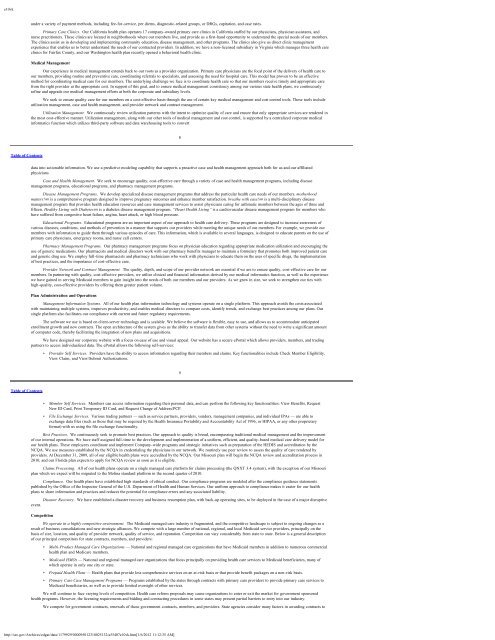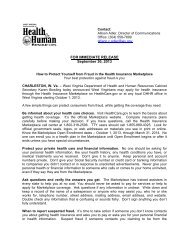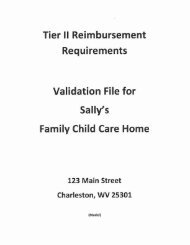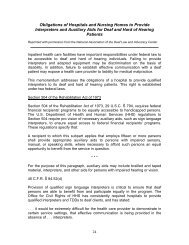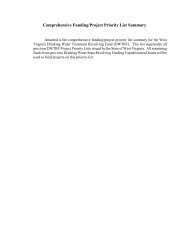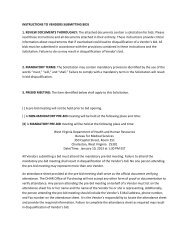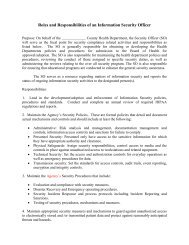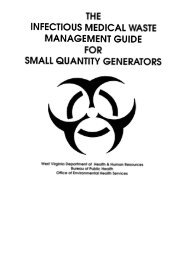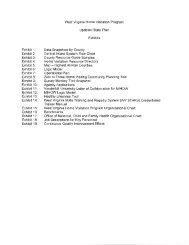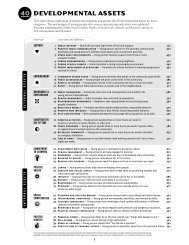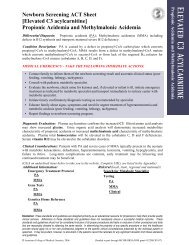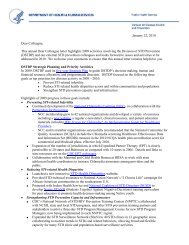Molina Medicaid Solutions - DHHR
Molina Medicaid Solutions - DHHR
Molina Medicaid Solutions - DHHR
You also want an ePaper? Increase the reach of your titles
YUMPU automatically turns print PDFs into web optimized ePapers that Google loves.
e10vkunder a variety of payment methods, including fee-for-service, per diems, diagnostic-related groups, or DRGs, capitation, and case rates.Primary Care Clinics. Our California health plan operates 17 company-owned primary care clinics in California staffed by our physicians, physician assistants, andnurse practitioners. These clinics are located in neighborhoods where our members live, and provide us a first-hand opportunity to understand the special needs of our members.The clinics assist us in developing and implementing community education, disease management, and other programs. The clinics also give us direct clinic managementexperience that enables us to better understand the needs of our contracted providers. In addition, we have a non-licensed subsidiary in Virginia which manages three health careclinics for Fairfax County, and our Washington health plan recently opened a behavioral health clinic.Medical ManagementOur experience in medical management extends back to our roots as a provider organization. Primary care physicians are the focal point of the delivery of health care toour members, providing routine and preventive care, coordinating referrals to specialists, and assessing the need for hospital care. This model has proven to be an effectivemethod for coordinating medical care for our members. The underlying challenge we face is to coordinate health care so that our members receive timely and appropriate carefrom the right provider at the appropriate cost. In support of this goal, and to ensure medical management consistency among our various state health plans, we continuouslyrefine and upgrade our medical management efforts at both the corporate and subsidiary levels.We seek to ensure quality care for our members on a cost-effective basis through the use of certain key medical management and cost control tools. These tools includeutilization management, case and health management, and provider network and contract management.Utilization Management. We continuously review utilization patterns with the intent to optimize quality of care and ensure that only appropriate services are rendered inthe most cost-effective manner. Utilization management, along with our other tools of medical management and cost control, is supported by a centralized corporate medicalinformatics function which utilizes third-party software and data warehousing tools to convert8Table of Contentsdata into actionable information. We use a predictive modeling capability that supports a proactive case and health management approach both for us and our affiliatedphysicians.Case and Health Management. We seek to encourage quality, cost-effective care through a variety of case and health management programs, including diseasemanagement programs, educational programs, and pharmacy management programs.Disease Management Programs. We develop specialized disease management programs that address the particular health care needs of our members. motherhoodmatters!sm is a comprehensive program designed to improve pregnancy outcomes and enhance member satisfaction. breathe with ease!sm is a multi-disciplinary diseasemanagement program that provides health education resources and case management services to assist physicians caring for asthmatic members between the ages of three andfifteen. Healthy Living with Diabetessm is a diabetes disease management program. “Heart Health Living” is a cardiovascular disease management program for members whohave suffered from congestive heart failure, angina, heart attack, or high blood pressure.Educational Programs. Educational programs are an important aspect of our approach to health care delivery. These programs are designed to increase awareness ofvarious diseases, conditions, and methods of prevention in a manner that supports our providers while meeting the unique needs of our members. For example, we provide ourmembers with information to guide them through various episodes of care. This information, which is available in several languages, is designed to educate parents on the use ofprimary care physicians, emergency rooms, and nurse call centers.Pharmacy Management Programs. Our pharmacy management programs focus on physician education regarding appropriate medication utilization and encouraging theuse of generic medications. Our pharmacists and medical directors work with our pharmacy benefits manager to maintain a formulary that promotes both improved patient careand generic drug use. We employ full-time pharmacists and pharmacy technicians who work with physicians to educate them on the uses of specific drugs, the implementationof best practices, and the importance of cost-effective care.Provider Network and Contract Management. The quality, depth, and scope of our provider network are essential if we are to ensure quality, cost-effective care for ourmembers. In partnering with quality, cost-effective providers, we utilize clinical and financial information derived by our medical informatics function, as well as the experiencewe have gained in serving <strong>Medicaid</strong> members to gain insight into the needs of both our members and our providers. As we grow in size, we seek to strengthen our ties withhigh-quality, cost-effective providers by offering them greater patient volume.Plan Administration and OperationsManagement Information Systems. All of our health plan information technology and systems operate on a single platform. This approach avoids the costs associatedwith maintaining multiple systems, improves productivity, and enables medical directors to compare costs, identify trends, and exchange best practices among our plans. Oursingle platform also facilitates our compliance with current and future regulatory requirements.The software we use is based on client-server technology and is scalable. We believe the software is flexible, easy to use, and allows us to accommodate anticipatedenrollment growth and new contracts. The open architecture of the system gives us the ability to transfer data from other systems without the need to write a significant amountof computer code, thereby facilitating the integration of new plans and acquisitions.We have designed our corporate website with a focus on ease of use and visual appeal. Our website has a secure ePortal which allows providers, members, and tradingpartners to access individualized data. The ePortal allows the following self-services:• Provider Self Services. Providers have the ability to access information regarding their members and claims. Key functionalities include Check Member Eligibility,View Claim, and View/Submit Authorizations.9Table of Contents• Member Self Services. Members can access information regarding their personal data, and can perform the following key functionalities: View Benefits, RequestNew ID Card, Print Temporary ID Card, and Request Change of Address/PCP.• File Exchange Services. Various trading partners — such as service partners, providers, vendors, management companies, and individual IPAs — are able toexchange data files (such as those that may be required by the Health Insurance Portability and Accountability Act of 1996, or HIPAA, or any other proprietaryformat) with us using the file exchange functionality.Best Practices. We continuously seek to promote best practices. Our approach to quality is broad, encompassing traditional medical management and the improvementof our internal operations. We have staff assigned full-time to the development and implementation of a uniform, efficient, and quality-based medical care delivery model forour health plans. These employees coordinate and implement Company-wide programs and strategic initiatives such as preparation of the HEDIS and accreditation by theNCQA. We use measures established by the NCQA in credentialing the physicians in our network. We routinely use peer review to assess the quality of care rendered byproviders. At December 31, 2009, all of our eligible health plans were accredited by the NCQA. Our Missouri plan will begin the NCQA review and accreditation process in2010, and our Florida plan expects to apply for NCQA review as soon as it is eligible.Claims Processing. All of our health plans operate on a single managed care platform for claims processing (the QNXT 3.4 system), with the exception of our Missouriplan which we expect will be migrated to the <strong>Molina</strong> standard platform in the second quarter of 2010.Compliance. Our health plans have established high standards of ethical conduct. Our compliance programs are modeled after the compliance guidance statementspublished by the Office of the Inspector General of the U.S. Department of Health and Human Services. Our uniform approach to compliance makes it easier for our healthplans to share information and practices and reduces the potential for compliance errors and any associated liability.Disaster Recovery. We have established a disaster recovery and business resumption plan, with back-up operating sites, to be deployed in the case of a major disruptiveevent.CompetitionWe operate in a highly competitive environment. The <strong>Medicaid</strong> managed care industry is fragmented, and the competitive landscape is subject to ongoing changes as aresult of business consolidations and new strategic alliances. We compete with a large number of national, regional, and local <strong>Medicaid</strong> service providers, principally on thebasis of size, location, and quality of provider network, quality of service, and reputation. Competition can vary considerably from state to state. Below is a general descriptionof our principal competitors for state contracts, members, and providers:• Multi-Product Managed Care Organizations — National and regional managed care organizations that have <strong>Medicaid</strong> members in addition to numerous commercialhealth plan and Medicare members.• <strong>Medicaid</strong> HMOs — National and regional managed care organizations that focus principally on providing health care services to <strong>Medicaid</strong> beneficiaries, many ofwhich operate in only one city or state.• Prepaid Health Plans — Health plans that provide less comprehensive services on an at-risk basis or that provide benefit packages on a non-risk basis.• Primary Care Case Management Programs — Programs established by the states through contracts with primary care providers to provide primary care services to<strong>Medicaid</strong> beneficiaries, as well as to provide limited oversight of other services.We will continue to face varying levels of competition. Health care reform proposals may cause organizations to enter or exit the market for government sponsoredhealth programs. However, the licensing requirements and bidding and contracting procedures in some states may present partial barriers to entry into our industry.We compete for government contracts, renewals of those government contracts, members, and providers. State agencies consider many factors in awarding contracts tohttp://sec.gov/Archives/edgar/data/1179929/000095012310025132/a55407e10vk.htm[1/6/2012 11:12:35 AM]


